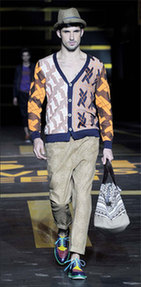The Milan plan
Updated: 2013-01-25 09:35
By Lv Chang and Hu Meidong (China Daily)
|
|||||||||||
|
Left and right: Models parade during Cabbeen's Spring-Autumn Collection 2013 show in Beijing. Photos Provided to China Daily |
Textile city of Shishi sets its sights on becoming an international fashion capital
The scene is familiar enough - an army of buyers, journalists, celebrities and VIPs line the runway and music blares as strutting models parade by, stitched up in their masters' latest creations. In this instance, it was Cabbeen's spring collection of menswear flouncing and glittering under the spotlights.
It could have been Paris, London or New York, even Shanghai or Beijing. But, no, this was Shishi, a small coastal city in China's southern Fujian province. And Shishi wants to be Milan - or, rather, to be considered a fashion capital like Milan. As a major manufacturing hub for fashion apparel, Shishi has the credentials, with its experienced craftsmen and budding world-class designers. It also has a "Milan Plan" to take the city on that long journey upmarket.
Shishi doesn't aim just to be the place where big fashion houses like Armani, Zegna or Prada find the perfect jacket producer. Instead, the city wants to help local companies develop their domestic brands into international ones and become renowned labels in their own right.
"Many of our clothing brands are mainly low- and middle-end ones, and lack the power to develop high-end brands, so if we don't do this, we face the possibility of dropping out of the market eventually," says Tian Qiming, chairman of Shishi Textile and Garment Chamber of Commerce and also of Edenbo Group, a local menswear brand.
Though Edenbo boasts of more than 3,000 stores nationwide, Tian says compared to foreign high-end brands, they still have a lot of catching up to do.
|
||||
"The high-end market in the domestic fashion industry is still dominated by foreign brands, because they have very strong design teams, professional marketing experts and a long history of brand building," Tian says.
Falling export figures coupled with fierce competition within the local fashion industry are also pushing Shishi's clothing companies to upgrade on the global value chain.
 |
"The Milan Plan" is to use the Chinese city's International Textile and Garment Center as a template to build a fashion capital like the Italian one.
With an investment of 4.35 billion yuan ($700 million, 524 million euros) and covering 188,000 square meters, the ITGC innovation industrial park of offices and design studios is expected to begin operating next year.
It aims to bring together designers, retailers, raw material suppliers, manufacturers and service providers, covering all sectors of the industry, in one location. This, it is hoped, will cut costs and improve original design and branding capabilities.
"Consolidation around a center is a clear path to victory, because joint efforts across all sectors will improve the effectiveness and allow for resource maximization," says the plan's creator, Xu Peiyuan, deputy director of the college of economics and finance at Huaqiao University.
Xu says they chose Milan as a model not just because it is the heart of fashion but also because the two cities have a lot in common.
"Both cities have a long history of manufacturing and benefit from a regional industry cluster," he says. "And more importantly, their family-owned businesses play a very important role."
Shishi is home to more than 1,000 textile and apparel companies, 90 percent of which are family-owned, and it is located in a golden triangle formed with Quanzhou and Xiamen Economic Zones, which accounts for more than 20 percent of China's textile and apparel production.
Related Stories
Keeping it in the family 2013-01-25 09:35
Men's wear wolf in the pack 2013-01-25 09:35
Today's Top News
Police continue manhunt for 2nd bombing suspect
H7N9 flu transmission studied
8% growth predicted for Q2
Nuke reactor gets foreign contract
First couple on Time's list of most influential
'Green' awareness levels drop in Beijing
Palace Museum spruces up
Trading channels 'need to broaden'
Hot Topics
Lunar probe , China growth forecasts, Emission rules get tougher, China seen through 'colored lens', International board,
Editor's Picks

|

|

|

|

|

|









